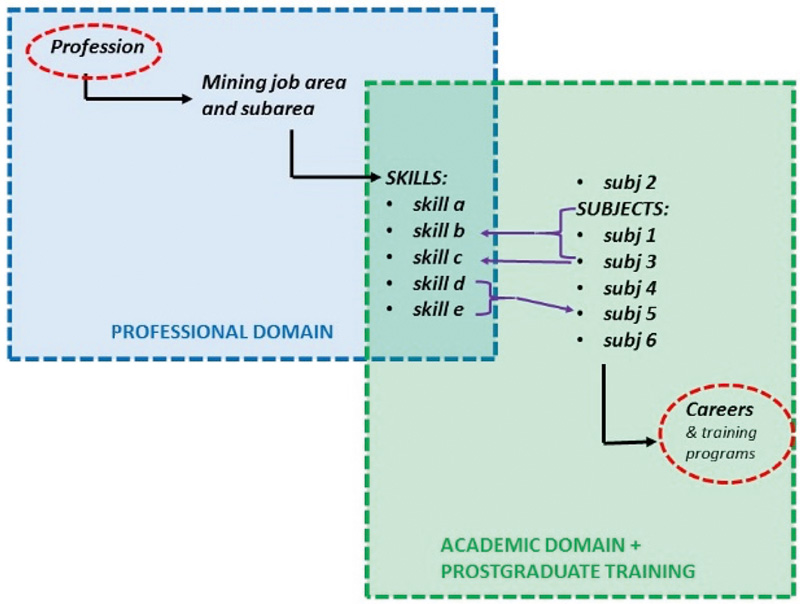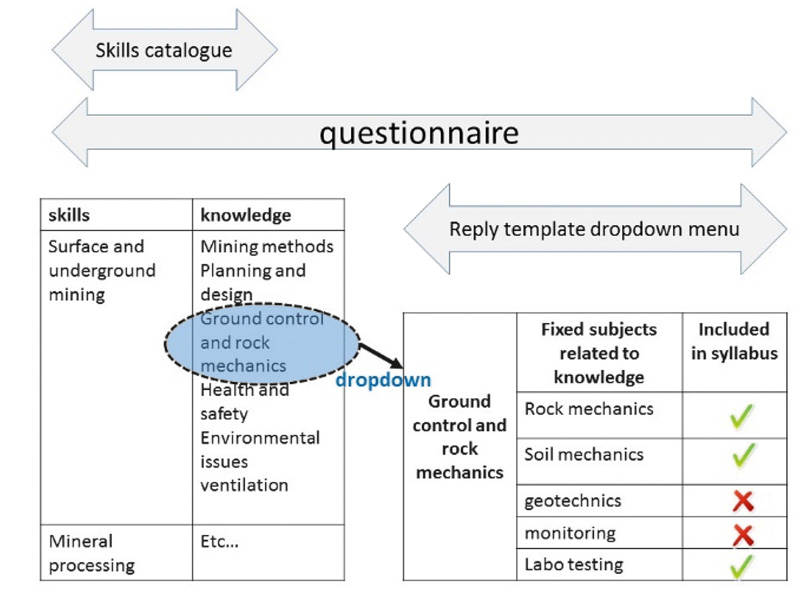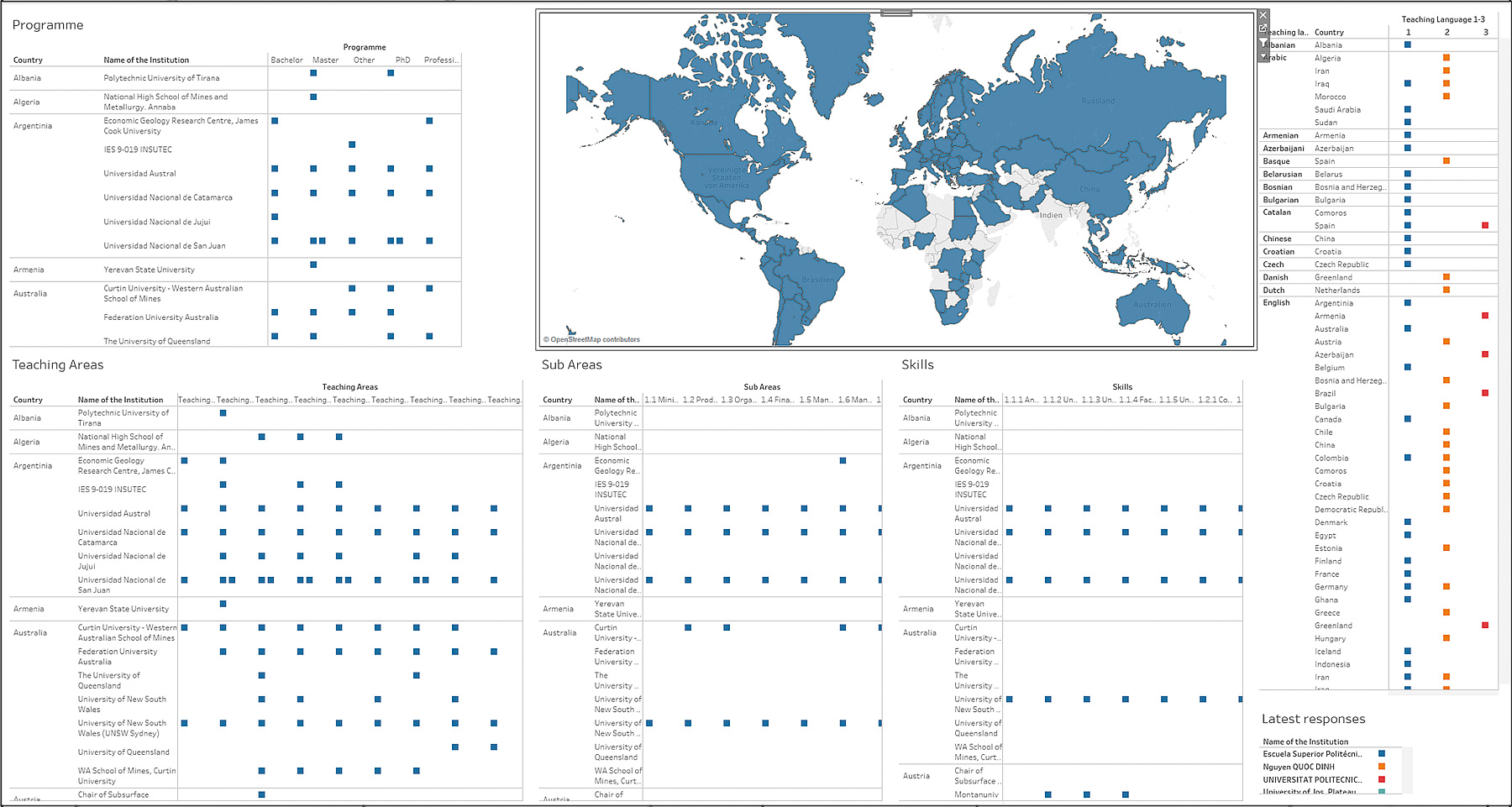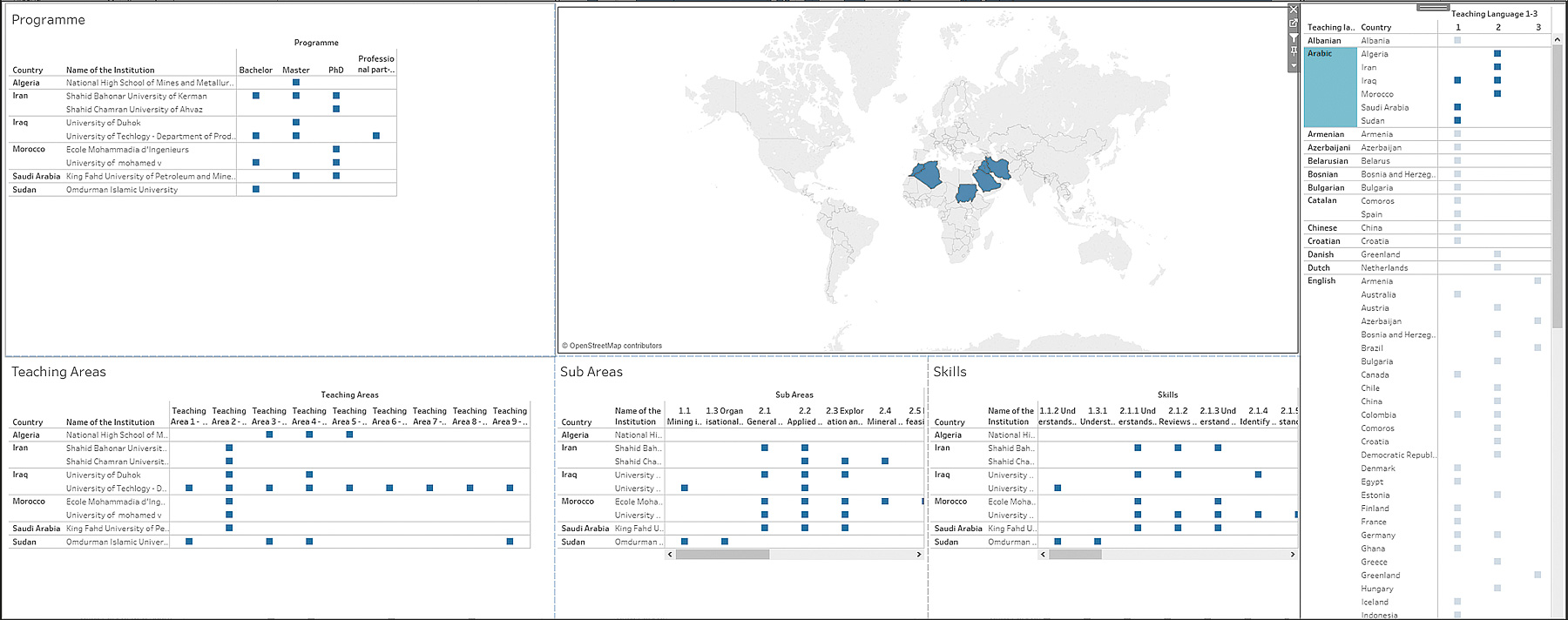This paper introduces the goals and objectives of INTERMIN. Furthermore, it highlights the benefits of the project to future students, professionals and academia and presents ways to contribute and interact with this project. It has undergone a peer review process. The paper was held at the 30th SOMP Annual Meeting and Conference which took place from 29th June to 5th July 2019 at the TH Georg Agricola University in Bochum/Germany.
1 Introduction
The H2020-Project INTERMIN started in February 2018 and will last a total of 36 months. Its goal is to create a feasible, long-lasting international network of technical and vocational training centers for mineral raw materials’ professionals. Specific objectives of the project are to develop common metrics and reference points for quality assurance and recognition of training and to create a comprehensive competency model for employment across the primary and secondary raw materials sector. INTERMIN activities will include:
- a) To develop an international qualification framework for professional education and training programs on mineral raw materials’ topics based on present and future requirements by employers.
- b) To foster joint international training programs by a merger of competences and scope of existing training programmes.
- c) To optimize future interaction and collaboration in Europe and internationally.
The project activities require contact with people and institutions as well as the collection, analysis, treatment and storage of primary data (data collected by the Consortium involved in INTERMIN) and secondary data (data collected by others and published or publically available). INTERMIN also includes the development of a repository, which consists of a database of documents used and generated by the project.
Finally the project aims at being a single point of contact for all who are interested in a raw materials related education, all who are offering this specific education and all who are interested in hiring people in these professions.
2 Skills and competences
INTERMIN builds on a logical structure, from the professional domain – where skills are usually applied – to the training domain – where the skills are acquired. Thus the global mining sector was analyzed and potential jobs domains generally needed in mining operations disregarding the specific profession that practices them – usually several professionals develop the same functions – were identified. On basis of the job description profiles found the detailed skills needed to perform such jobs are described.
This system can then be used to locate the subjects from the different training centers or programmes that can provide such skills or learning outcomes.
This way, the INTERMIN portal will be able to work both ways, from the job domains or from the knowledge domain, and users will be able to define exactly their needs and training requirements.
Considering this cascade it is evident that there is a need for a clear definition of the terms used in this context, i. e. to differentiate between skills and competences, e. g. ESCO establishes “essential skills and competences” (EMPL 2018b).
2.1 Skills
If one takes the definition of skill from the Cambridge Dictionary (Cambridge Dictionary 2019), he finds that a skill is “an ability to do an activity or job well, especially because you have practised it”. Skill is thus, an ability normally acquired by practise.
This definition is very relevant as it links the knowledge acquired with the practical use of such knowledge.
The Collins dictionary (Collins Online Dictionary 2019) establishes two types of nouns:
- Countable nouns: A skill is a type of work or activity, which requires special training and knowledge.
- Uncountable noun: A skill is the knowledge and ability that enables you to do something well.
This is probably the reason why according to ESCO there is no distinction between skills and competences (EMPL 2018a). The ESCO skills pillar distinguishes between the skills/competences concept and the knowledge concepts. This is done by indicating skill types.
2.2 Competences
On the other hand competencies, in the most general terms, are “things” that an individual must demonstrate, to be effective in a job, role, function, task, or duty. These “things” include job-relevant behaviour (what a person says or does that result in good or poor performance), motivation (how a person feels about a job, organization, or geographic location), and technical knowledge/skills (what a person knows/demonstrates regarding facts, technologies, a profession, procedures, a job, an organization, etc.). Competencies are identified through the study of jobs and roles.
Competence is then the ability to do something successfully or efficiently.
2.3 Knowledge
In this context knowledge are the facts, information and skills acquired through experience or education; the theoretical or practical understanding of a subject.
2.4 Learning outcomes
Learning outcomes are statements that describe the knowledge or skills students (or trainees) should acquire by the end of a particular assignment, class, course, or program, and help students understand why that knowledge and those skills will be useful to them. They focus on the context and potential applications of knowledge and skills, help students connect learning in various contexts, and help guide assessment and evaluation. Good learning outcomes emphasize the application and integration of knowledge. Instead of focusing on coverage of material, learning outcomes articulate how students will be able to employ the material, both in the context of the class and more broadly. Learning outcomes are thus statements of what a learner is expected to know, understand and/or be able to demonstrate after completion of a process of learning.
3 Methodology
In order to realise this structure with a special mining and raw materials focus a skills catalogue was developed. The catalogue is linked to an online questionnaire (https://intermin.limequery.com/324595?lang=en) in which all education providers are invited to submit information about their programmes and teaching activities.
The skills catalogue defines two levels: skills and knowledge. Although these two terms can be quite confusing in the definitions provided since the only difference seems to be that skills are associated with practising and knowledge with experience. However, how can one gain experience without practising? Skills are often assigned to the mining job area while knowledge to the learning outcomes. The exhaustive INTERMIN table of skills includes both and keeps the “academic domain” of subjects for the further questionnaire. This discrimination is maybe less encyclopedically supported but it is used as a working template for the survey, which is the INTERMIN Table of Knowledge Skills and Subjects.
The survey pursues an approach to design it in a tree-like structure, which contains a choice of the main professions, the education programme is directed towards and followed by the mining job areas which the graduates of the profession cover. The mining job areas are segmented into sub-areas addressing the job area in more detail. Subsequently the survey supplies a broad selection of learning outcomes to tick which provide the basis of professional practice. The survey strictly accords to the INTERMIN Table of Knowledge and Skills reducing individual denotations and classifications by the respondents as far as possible which reduces the effect of distorted assessment while converting the reply of the respondents into entries of a database.
In the questionnaire in the level of knowledge and learning outcomes tick boxes will be opened indicating if it covers that particular subject or not. Therefore, it is important to reach a consensus on which the subjects are that will be included in each knowledge (Figure 1). The entries of the skills/knowledge and learning outcomes can be formulated as topics of the academic programme.
In the questionnaire, only specific knowledge and subjects are included. The core subjects such as chemistry, technical drawing, programming, etc, are not included and it will be analysed if it is necessary to include them in future.
The main problem faced is that the skills catalogue must be aligned with the further questionnaire. It should be comprehensive enough to have all the skills required but also easy to fill in. The chosen approach is to develop within this document a skills catalogue as comprehensive as possible, but keeping in mind that it can be shortened for use in a questionnaire that can be filled in reasonable time by any training centre or university in the world.
The sources of the skills included into the catalogue/table come from Mining Education Australia MEA 2015; American Geo-logical Institute (AGI) 2012; Geoscientists Canada 2014 and are amended by own elaborations on the subject.
The catalogue is structured in three main blocks (Figure 2):
- profession/typically related to a skill;
- mining job area and subareas; and
- skills and knowledge outcomes (both are integrated in order to facilitate a better selection process in the questionnaire).
4 Preliminary Results
The survey was made available to the public in September 2018. Since then more than 200 educational institutions from 92 countries have provided information about their teaching programmes in raw materials education. The results are made available for the general public on the Intermin website (https://interminproject.org/preliminary-survey-results).
The users can interact with this interface, click on different icons and browse through the content. Figure 3 shows the general layout of this interface.
By e. g. clicking on one teaching language, all relevant programmes which are offered in this language can be displayed. Figure 4 gives an example for Arabic language. In this way, the users can scroll through all relevant content and compile an evaluation/output in their own interest.
5 Discussion and outlook
The goal of INTERMIN is to provide a platform for all people interested in raw materials education, future skills, and mining professionals. This platform should be self-sustainable and conclusive for all related study programmes and professional areas – from geology, to mining to management and more. By achieving a return rate of more than 200 answers in the first run of the survey, INTERMIN is on an excellent track achieving this goal. According to our assumptions there are roughly 600 institutions world-wide offering such programmes. As can be seen from the results the answers cover more or less the entire wold. However, some large countries, e. g., Russia, USA, are only represented by one or very few institutions. Hence, there is definitely a need to improve the performance in these areas.
However, also the present setup enables those who interact with the database a very conclusive look of many offerings in the related sectors. Institutions represented in this database will definitely have an advantage over those who are not listed.
The INTERMIN project does not aim at providing a ranking or any hierarchy of “good” or “bad” institutions or programmes. It is solely dedicated to provide informations about different study programmes and opportunities for students, but also for people seeking post-graduate education.
Depending on their interest and role INTERMIN offers diverse ways of interaction with the project:
Individuals are mostly interested in finding different study programmes or in advancing their expertise in specific areas. They will interact with the online database and overview of the different contents (https://interminproject.org/preliminary-survey-results).
Training facilities which want to be present in this database can always enter their information by taking 20 min and answering the INTERMIN online questionnaire (https://intermin.limequery.com/324595?lang=en). Their information will then automatically be updated in the database and web-interface. The future plan is to provide a more sophisticated tool where the institutions can enter information about changes in their programmes with less effort on a regular scheme. This will guarantee for continuous improvement of the contents and a growing database.
Training facilities, professional organisations, employers or similar who actively want to participate in the INTERMIN project and interact with the consortium are encouraged to contact us to discuss their potential role.
Professional organisations and employers who are looking for specific skills and knowledge amongst their workforce can search the database to find out which institutions educate people most suitable for the given job.
6 Conclusions
The INTERMIN project aims at creating a self-sustainable and long lasting repository of raw materials education institutions and their programmes. In a first step, a list of skills and knowledge required by the mining industry has been compiled. This list was the basis for an online questionnaire.
Up to now the questionnaire was answered by more than 200 institutions from 92 countries world-wide, making this one of the most conclusive databases of its kind.
All kinds of people related and interested in the raw materials industry can constantly interact with the project and provide or retrieve information, depending on their needs.
Acknowledgements
This project has received funding from the European Union‘s Horizon 2020 research and innovation programme under grant agreement No 776642.
References
References
American Geological Institute (AGI) (2012): Critical Needs for the Twenty-first Century. The Role of the Geosciences. Available online at https://www.americangeosciences.org/sites/default/files/CriticalNeeds2012.pdf, checked on 10/17/2019.
Cambridge Dictionary (2019): Cambridge Dictionary | English Dictionary, Translations & Thesaurus. Available online at https://dictionary.cambridge.org/, checked on 9/30/2019.
Collins Online Dictionary (2019): Collins Online Dictionary | Definitions, Thesaurus and Translations. Available online at https://www.collinsdictionary.com/, checked on 9/30/2019.
EMPL, D. G. (2018a): ESCO – European Commission. Available online at https://ec.europa.eu/esco/portal/home, updated on 4/26/2018, checked on 9/30/2019.
EMPL, D. G. (2018b): ESCO – Skills/competences – European Commission. Available online at https://ec.europa.eu/esco/portal/skill, updated on 4/26/2018, checked on 9/30/2019.
Geoscientists Canada (Ed.) (2014): Geoscience Knowledge and Experience Requirements for Professional Registration in Canada.
Mining Education Australia MEA (Ed.) (2015): A graduate Capability Framework for the Mining Engineering Degree Programme. A Guide for MEA Universities.




